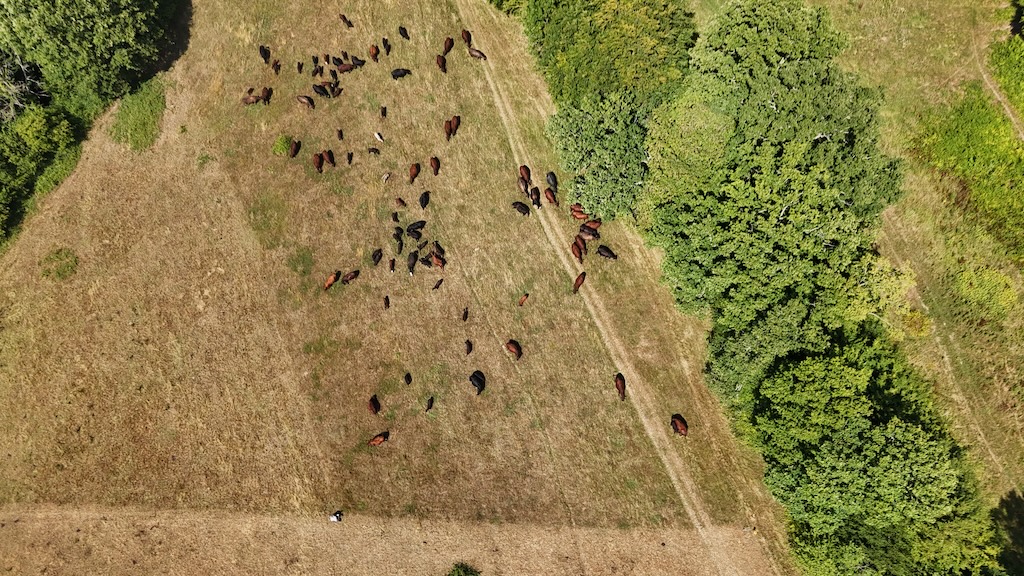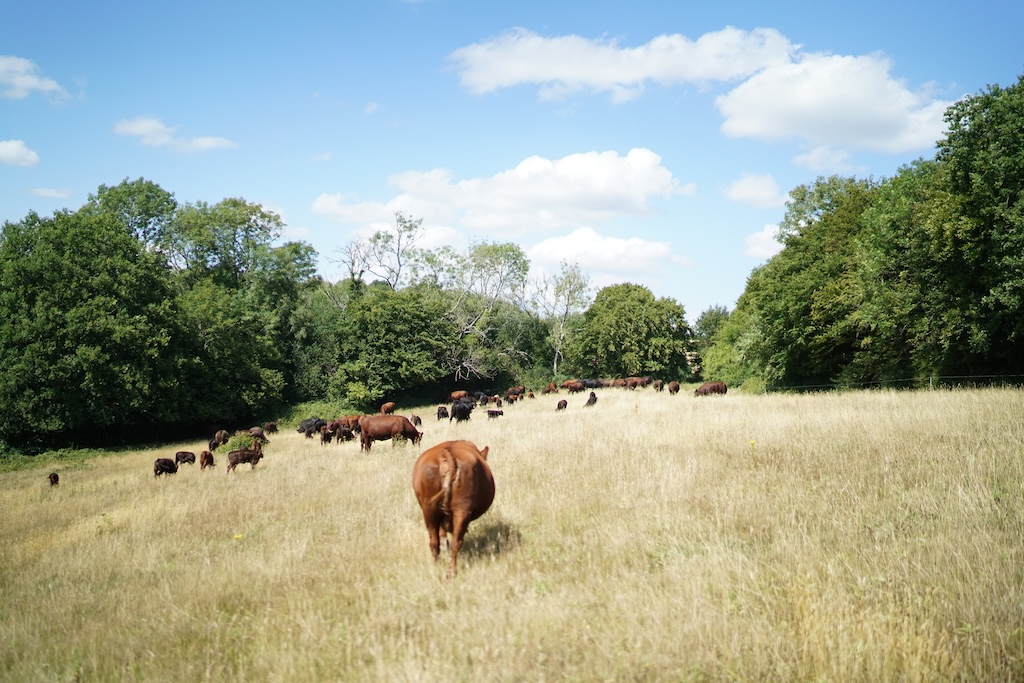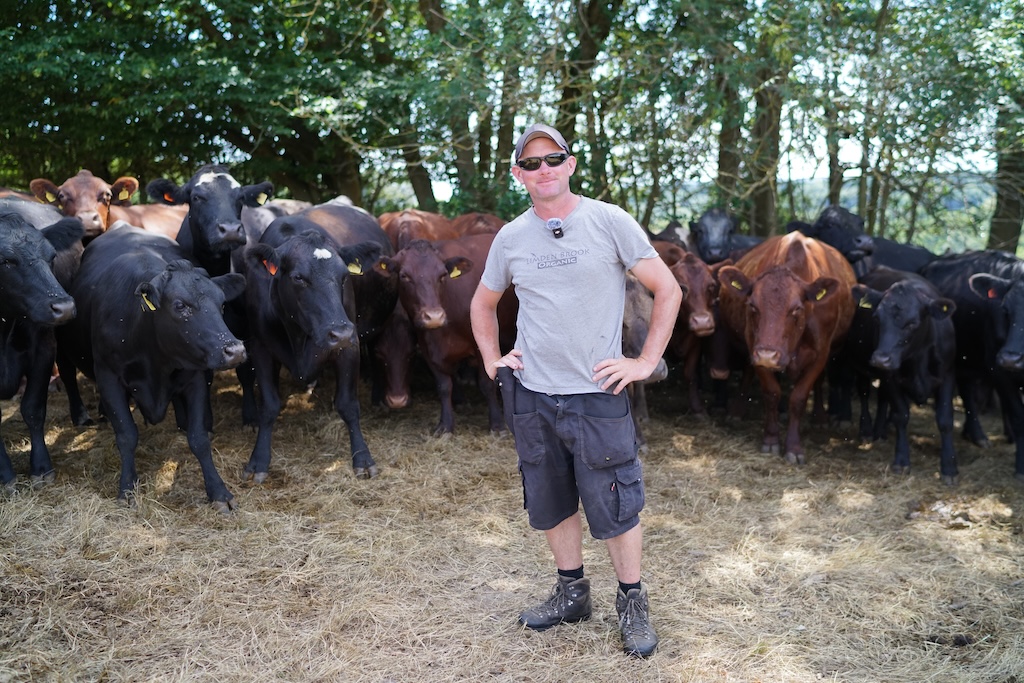Limden Brook, a 450-acre farm of permanent pasture, floodplain meadows and wooded banks in the Limden Valley, has been home to the Newington family for more than 120 years. Today, fifth-generation farmer Sam Newington and his wife Becky run a herd of 55 suckler cows, producing 100% pasture-fed beef for local butchers and direct sales. In this second article supported by the Lund Trust and the High Weald National Landscape exploring farms across the High Weald and beyond, we look at mob grazing, soil health, climate resilience and the challenges — and opportunities — facing family farms committed to working with natural cycles.
On a warm and dry summer’s morning in the rolling folds of the High Weald, I meet Sam Newington at Limden Brook, a 450-acre patchwork of permanent pasture, floodplain meadows and wooded banks.
Sam is a fifth-generation farmer here in the Limden Valley. His great-great-grandfather, James Newington, took on the tenancy more than 120 years ago, buying parcels of land as the years went on. “What we’re farming now is the original family farm plus two other rented farms,” he explained.
Today, Sam together with his wife Becky, run 55 suckler cows, finishing all the followers for local butchers and selling a little directly from the farm freezer. It’s a business built around quality 100% pasture for life certified beef, but also around a grazing system that aims to work with — rather than against — natural cycles.
Mob Grazing and Managing for Resilience
Sam is one of the early adopters of mob (or adaptive multi-paddock) grazing in this part of Sussex — moving cattle regularly and giving pastures longer rest periods.
“It’s called lots of different things, and everyone does it slightly differently,” he said. “It depends on your context, your stock class, how you make money, the weather… Generally, we’re aiming for longer rest periods. When the grass is growing, we move them faster. In a dry spell like now, we slow right down to make the forage last.”
In a wet year, cattle might rotate around every 40–50 days. In a drought, that rotation can stretch to 120 days or more. “It does mean there’s less residue left behind, but it’s about stretching what we have until the rain returns.”

Nature as the Blueprint
Sam’s philosophy is rooted in observation. “It’s about mimicking nature, seeing how it all fits together. Are the cows getting what they need? The right minerals? Enough browse? Enough shade? And how does that tie into the wider ecosystem — the dung beetles, the birds that follow them?”
His approach isn’t radically different from some conventional systems — other than the fact he moves his cattle far more often than most local farmers. “It’s small tweaks, but they make a difference over time,” he said.
Grass-Fed Beef with a Difference
The beef itself, Sam believes, benefits from the system — and from the skill of his butchers. “Our beef is slaughtered in a nicer place, hung properly, and cut with care. Supermarket beef is slaughtered at an industrial abattoir and often wet-aged in vac-packs — it tastes different. Our fat tends to be more yellow from the grass, and I think you can taste the difference. Grain-fed fat can be greasier.”
From a health perspective, he pointed to studies suggesting grass-fed beef has a better omega 3 to omega 6 ratio. “It makes sense that healthier cattle produce healthier meat,” he said.

Adapting to a Changing Climate
Has he noticed the climate shifting? “Definitely warmer winters,” he replied. “Thirty years ago, the ground would freeze for months. Now the grass keeps growing. Rainfall patterns are harder to read — some years are bone dry, others wet.”
For Sam, the key is building flexibility into the system. “If you’ve got a wedge of grass in front of you, you’ve got options. You can graze it later if needed. That adaptability is everything.”
The Balancing Act: Profitability and Labour
Running a low-input system means buying in less fodder and no fertiliser, but it does require more labour. “We spend more time moving cows and putting up fencing, but less on machinery,” he said. “It’s swings and roundabouts. Some people would rather be on a tractor, others with livestock. You have to choose the system that suits you.”
Grants, Hedgerows, and Habitat
Grant funding has helped with infrastructure for rotational grazing and hedge-laying. “The fencing makes us more resilient, and the hedge-laying is great for wildlife. We’ve had stewardship grants and farming in protected landscapes funding [FiPL], and we basically repeated the same package across the farm.”
Birdsong and Beetles
Biodiversity appears to be on the rise. “We see more birdlife and insects — though it’s hard to know if that’s partly because we’re looking more,” he said. Bird counts from a local volunteer are encouraging. “Nature is boom or bust — some years are fantastic, others not. That’s just how it works.”
Diversification or Focus?
Unlike many farms, Limden Brook doesn’t have holiday lets, farm shops or wedding venues. “Our diversification is direct beef sales. It does make us more vulnerable if the beef price drops,” Sam admitted. “Diversification can spread the risk — but it’s also another job. You can lose focus.”
Advice for New Entrants and Landowners
His advice for aspiring farmers? “Go and see as many farms as you can. Ask how profitable they are. Don’t just look at the pretty bits — see the accounts if they’ll show you. Otherwise you get a false picture.”
And for landowners with fields they don’t know what to do with? “Find a keen local grazier and work out what they need. It’s about building a relationship.”
On the Future of Farming
Sam’s hope is for less over-regulation. “Some rules are essential, but some are pointless. Rolling it back might mean we have to reinstate the good bits we lose — but small abattoirs, for example, need more freedom to survive. Without them, farmers are stuck selling to supermarkets, which isn’t healthy for the industry long term.”
He’s a fan of Clarkson’s Farm for raising awareness — even if some of the drama is played up for the cameras. “It’s entertaining, and it gets people talking about farming.”
Inspiration and Resources
His recommended watches include Rachel’s Farm and Six Inches of Soil. Book-wise, he cites David R. Montgomery’s Dirt: The Erosion of Civilisations as essential reading, alongside Gabe Brown and Greg Judy’s work.
“You learn a lot from history — the rise and fall of civilisations often came down to soil. That’s a lesson worth remembering.”
More Information
To help bring the series to life, I also filmed and edited short video episodes from each of my farm visits, which you can watch over on my Indie Farmer YouTube channel. Click here to watch my episode on Sam.



